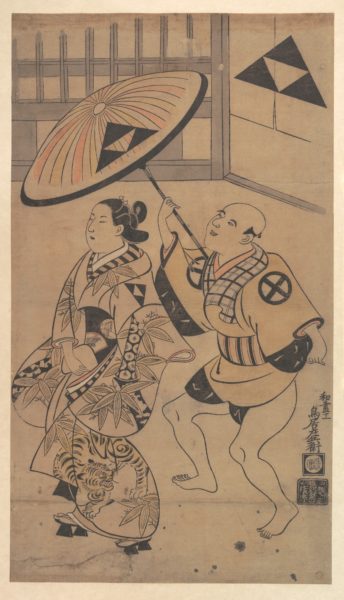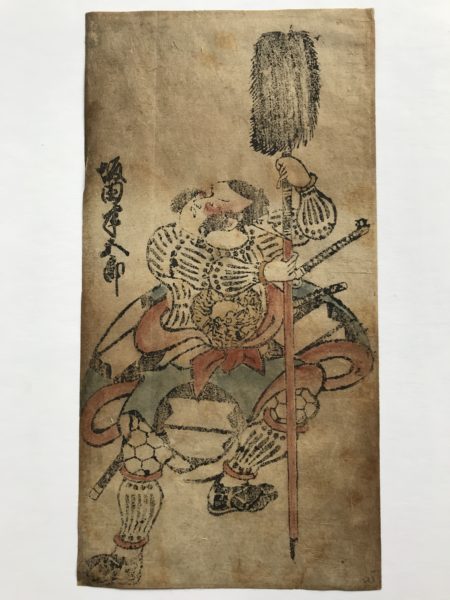We have always been taught that the 1760s would see quite drastic changes, like someone pushing the button and lo and behold, there is the Floating World in multicolour. But is there more than just the birth of full-colour printing, the development of the so-called ‘brocade prints,’ nishikie (錦繪). And is there any effect of that innovation of multicolour printing, other than the numerous privately issued egoyomi (繪暦) for 1765 and 1766 and the Katsukawa trying to overpower the Torii portraits of actors. Is there more than just Suzuki Harunobu (1724?-1770, act. 1760-70) and Katsukawa Shunshō (1726-1793, act. 1764-1793). Are we indeed living in a different world?
Anyway, I am afraid that 1765 has become too much of a magical date – more about that later. What we see in single prints in the 1760s is a considerable decline, at least just focusing on the benizurie prints that Higuchi is listing (but still have to incorporate also Mutō’s database). His total for the 1740s is a pretty sound 188, but dropping to 129 in the 1750s – which is well before the development of full-colour printing – and again decreasing by almost 50% in the 1760s, to 100. Would this mean that the single prints from the latter half of the 1760s were all full colour prints?
As we saw before, tane were mostly produced simultaneously with black and white prints, from 1678 until circa 1723, whereas urushie had already been developed from 1717. And urushie then continued to be produced until circa 1752, with benizurie making their appearance as early as in 1744. And so we must also realize that mastering the technique of colour printing would not change the landscape of prints overnight. Indeed, we find benizurie still being published in the years 1766-68 (Torii Kiyohiro [act. 1752-68] and Kitao Shigemasa [1739-1820, act. 1765-1820]), or even as late as in the years 1770-73 (Kiyonaga, the fifth generation head of the Torii studio). Many regular buyers of prints were obviously simply happy with the benizuri portrayals of actors of the kabuki theatre that they had been buying for so many years. Moreover, and more importantly, it looks as if they simply had to still their hunger with benizurie, as they did not happen to belong to the circles that had access to the novel colour prints – as I will explain later on.
And how did other formats fare? Picture books of various kinds, mostly works with just illustrations and brief captions, but also of the ehon type that Sukenobu developed in the 1740s with illustrations to longer bits of text, these number like 58 in the 1740s, created by 12 artists, a figure almost doubled in the 1750s to 112 works by 23 artists. Actually, this is not very disparate in the 1760s, with 105 works created by 26 artists, with 5 artists being responsible for one single work only. But these are total figures. If we just focus on Edo productions, we are talking about a mere 15 works by three artists in the 1740s. For the 1750s, the figure is somewhat better, with 45 picture books by eight Edo artists, and in the 1760s we finally see some difference with the Edo production at almost half of the total of 105, with 50 picture books by nine artists.
This actually shouldn’t really surprise us, as we see the same in publishing in general: until the 1770s, the total production of books by Kyoto and Osaka publishers is far more than what Edo publishers produce. It is only from the 1770s that Edo publishers beat the combined production of Kyoto and Osaka publishers, and that is the situation until this day.[1]
If we also include enpon with the picture books – assuming that these were not really seen as very different at the time – the figure of 58 for the 1740s becomes 74, now by 13 artists. And for the 1750s, the figure of 112 becomes 122 by 25 artists, and for the 1760s this would be 105 plus 29 works by 11 artists (5 from Edo), which is different – but still nothing compared to what difference enpon would make in the 1770s.
For real change, we probably have to focus on popular novels of various sub-genres, such as ukiyozōshi, yomihon, kokkeibon, sharebon, hanashibon, akabon, kurohon, aohon, and kibyōshi, known collectively as kusazōshi (草双紙). Here we see eleven popular novels illustrated by 5 artists in the 1740s. This number is more than doubled in the 1750s, to 25 novels illustrated by 11 artists (three of which did the illustrations of one novel only, and one person only illustrated two novels). And in the 1760s this is more than quadrupled to 114 various kinds of novels illustrated by 12 artists (one being responsible for one work only, and another single person doing the illustrations of only two novels). So this is really booming, it seems.
[1] With the total production of 590 books in Kyoto and Osaka combined, versus 470 in Edo in the period 1727-49, and 1335 versus 1265 in the period 1750-74, this becomes 975 versus 1190 in the period 1775-1799, or even 510 versus 1130 in the period 1800-14.


